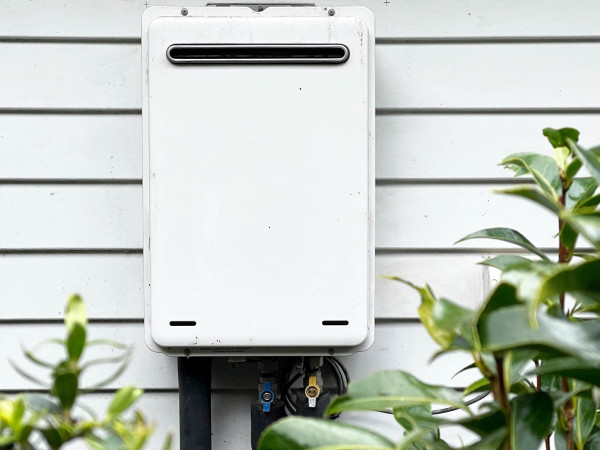NZS 5442(Int):2024 revision leads the way for biomethane use
A 16-year-old standard has been updated to allow for changes in the type of gas we will use to fuel our homes and workplaces.

A typical home gas boiler. N. Cottrell
Newly revised into an interim standard to meet industry needs, NZS 5442(Int):2024 supports the safe blending of biomethane within the reticulated, or piped, gas network. The final and fully revised version of this standard, which should follow at a later date, is expected to additionally allow blending of hydrogen gas within the gas distribution network, an important step in New Zealand’s adaptation towards more renewable energy sources.
Biomethane comes from anaerobic digestion by micro-organisms breaking down organic matter in discarded food waste and farm waste (manure). Currently, much of this is simply burnt away with the focus being on waste removal rather than energy supply. However, a study by First Gas, engineering firm Beca, and Fonterra, found that 4% of the country’s energy-related emissions could be avoided by using low-emitting, renewable alternatives such as biomethane.
Acting Standards Development Manager Nick Ascroft says:
‘While many consumers may be unaware of the type of gas running through their pipes, the changes NZS 5442(Int):2004 sets out have the potential to provide some clarity for installers and manufacturers in the industry and lead the way for more renewable energy sources. The standard plays a role in giving direction and safety assurance.’
Why an interim standard
The main aim is to ensure a specification exists for blending of methane-based gases supplied to consumers so that the gas is suitable for transportation and safe for use in gas-burning appliances and existing equipment.
When a standard is technically incomplete but is required urgently, or where it is to be used for a limited period, an interim standard may be produced. This should be reviewed within 12 months of publication and a decision made about whether it continues as an interim standard for a limited time, be withdrawn, or be turned into a regular New Zealand standard.
While initial needs addressed in this interim standard are focused on the blending of biomethane within the reticulated gas network, the final and fully revised version of this standard is expected to additionally allow blending of hydrogen gas within the gas distribution network.
This interim standard applies to all methane-based gases that come from natural petroleum sources, landfill drainage, biogas production and coal seam drainage. These sources provide gas for direct or blended supply on a commercial basis through open access supply systems for use in:
- Gas-burning appliances complying with NZS 5266 and installed in accordance with AS/NZS 5601.1;
- Compressed natural gas (CNG) compressors and refuelling facilities complying with NZS 5425 Parts 1 to 4;
- Natural gas-powered vehicles complying with AS/NZS 2739.
NZS 5442(Int):2024 does not apply to methane-based gas for supply as a feedstock but may provide a basis for such a specification.
What’s included in the standard
The standard has been developed with input from across engineering, energy supply, safety management and specialist trades with committee representatives from Bioenergy Association, Callaghan Innovation, Energy Resources Aotearoa, Gas Appliance Industry, Gas Association of New Zealand (GasNZ), Gas Industry Company, GNS Science, Hiringa Energy, HyPotential Limited, Master Electricians, Master Plumbers, Gasfitters and Drainlayers, Methanex New Zealand, New Zealand Energy Certificate System (NZCES), WorkSafe New Zealand – Energy Safety and Worley.
Part of this standard provides specification limits for gas characteristics, contaminants and components to ensure safe use of existing appliances and transportation systems across New Zealand. It provides certainty for manufacturers when providing appliances for use in the New Zealand market and for installers when setting up those appliances.
Certain limits defined in the specification can be exceeded under certain circumstances without compromising safety, but this must be a matter of competent technical review, specific to the conditions at the time and accepted by the pipeline operator.
In this edition, the introduction of biomethane has been formalised, and the test methods and frequencies have been reviewed and updated. Because biomethane has been introduced, the limit for oxygen has been relaxed and, relatedly, the limit for water has been reduced.
Existing appendices have been reformatted and new ones added. Key changes include revised definitions and a new, informative Appendix A that details the types of biomethane sources and associated possible contaminants. Normative requirements are outlined in Appendix B for processed biomethane. Other informative appendices (C, D, and E) from previous revisions have been reviewed and updated. Particular attention has been given to Appendix D (previously Appendix B), which has been updated with more detailed guidance on test frequencies and demonstration of compliance. Appendix G has been reserved as informative to enable the future integration of hydrogen.
NZS 5442(Int):2024 Specification for reticulated natural gas, supersedes NZS 5442:2008 and is available in late April 2024 from Standards New Zealand’s webshop.
